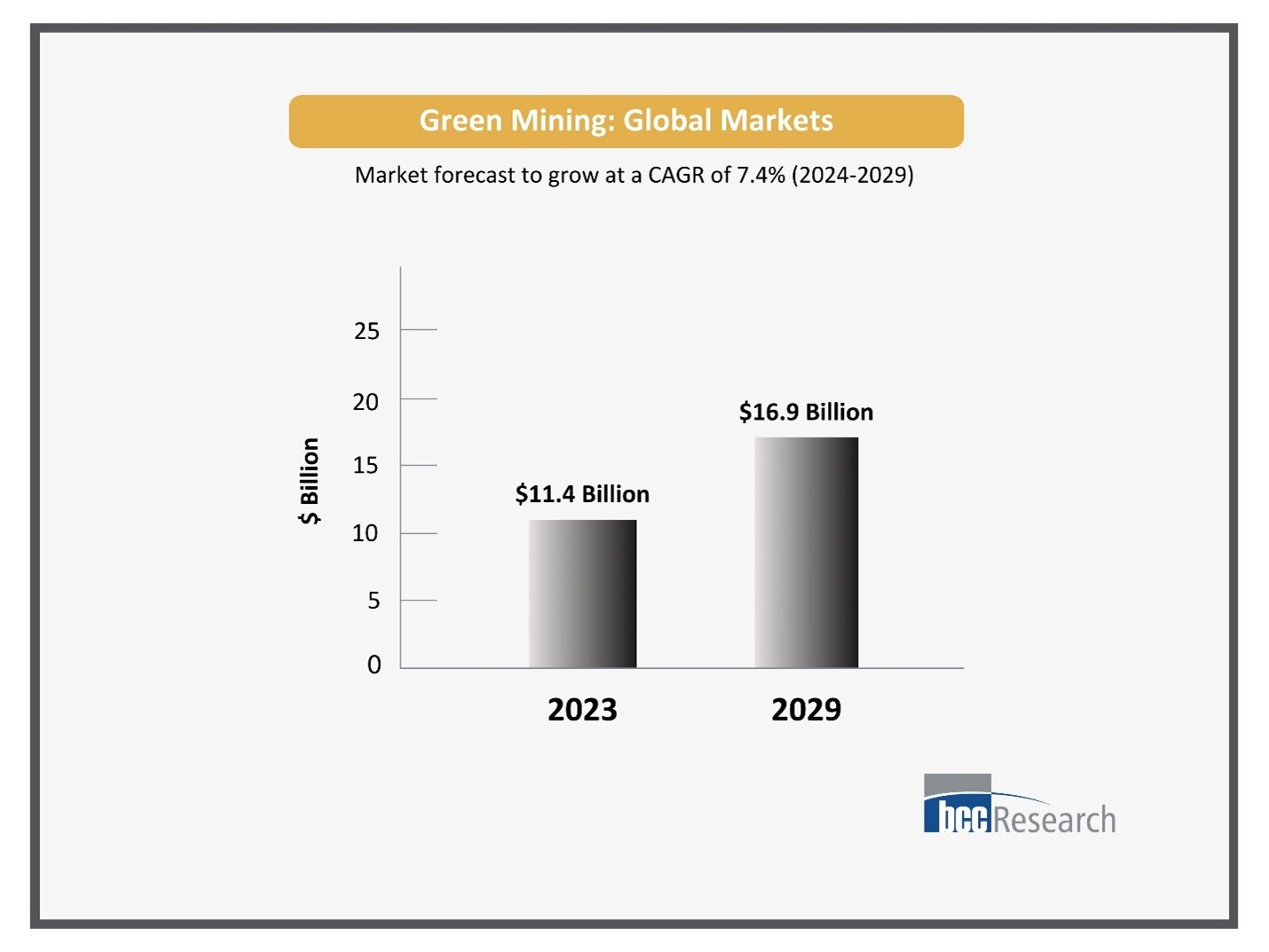
Aug 27, 2024
Blog Energy & Sustainability Green Mining Market Growth: Trends, Key Players, and FAQs
The green mining market is transforming the traditional mining industry by incorporating sustainable practices and innovative technologies. This approach focuses on minimizing environmental impact and enhancing the efficiency of resource extraction. As global demand for minerals grows, green mining practices become increasingly important for meeting regulatory standards and resolving environmental concerns, paving the way for a more sustainable future in mining.
Here, we'll explore key trends, spotlight major industry players, examine the challenges and opportunities within the market, and address frequently asked questions (FAQs) about green mining.
According to BCC Research, the global green mining market is projected to grow from $11.4 billion in 2023 to $16.9 billion by 2029, reflecting a compound annual growth rate (CAGR) of 7.4% between 2024 and 2029. This expansion is fueled by increasing demand for sustainable mining practices, stricter environmental regulations, and the adoption of advanced mining technologies.

The global market for green mining is estimated to increase from $11.4 billion in 2023 to reach $16.9 billion by 2029, at a compound annual growth rate (CAGR) of 7.4% from 2024 through 2029.
Rio Tinto is a global mining giant known for its commitment to sustainability. To reduce its carbon footprint, the company has invested heavily in renewable energy projects, like solar and wind power. Rio Tinto's "Mine of the Future" program focuses on automation and energy-efficient technologies to enhance safety and sustainability.
Anglo-American has made significant strides in sustainable mining through its "FutureSmart Mining" initiative. This program leverages digital technologies, advanced data analytics, and cleaner mining techniques to reduce environmental impact. Anglo-American is also a pioneer in using hydrogen-powered trucks, which significantly reduces emissions.
BHP is another leader in the green mining market, committed to reducing its operational impact on the environment. The company has set ambitious targets to achieve net-zero emissions by 2050. BHP is investing in carbon capture and storage (CCS) technologies and renewable energy projects to power its mining operations sustainably.
Vale has integrated sustainability into its core operations, with an emphasis on reducing greenhouse gas emissions and increasing biodiversity. The company is developing dry processing methods that minimize water usage and tailings dam risks. Vale's initiatives in reforestation and ecosystem restoration also set a benchmark in the industry.
Barrick Gold has embraced green mining by implementing energy-efficient practices and lowering its carbon footprint. The company is investing in solar power projects, such as the 200-megawatt solar power plant in Nevada and exploring the use of electric vehicles in its operations. Barrick's focus on sustainable development includes partnerships with local communities and environmental conservation initiatives.
Challenges:
Opportunities:
The green mining market is rapidly evolving, driven by the integration of sustainable practices and advanced technologies. With the market projected to grow to $16.9 billion by 2029, reflecting a compound annual growth rate (CAGR) of 7.4%, this sector is set to transform the mining industry. As key players and innovative trends continue to shape this market, green mining stands at the forefront of a more sustainable and environmentally responsible future in resource extraction.
A1: Green mining refers to environmentally friendly mining practices that use sustainable technologies and methods to reduce the ecological impact of mining operations.
A2: Green mining is important because it decreases environmental impact, conserves natural resources, and supports sustainable development in the mining industry.
A3: Renewable energy reduces the reliance on fossil fuels, lowers carbon emissions, and decreases operational costs, making mining operations more sustainable.
A4: Europe holds the highest share, which is 35.4%, in the green mining market in 2023.
A5: Future trends include the growing use of AI and IoT for efficiency, increased focus on biodiversity conservation, blockchain for supply chain transparency, and carbon capture and storage (CCS) technology.

Karishma Arora is an Assistant Team Lead in Marketing Operations at BCC Research, with a master's degree in commerce. She is a passionate marketer with a knack for creativity and data-driven strategies.

Electrical switches—devices that control the flow of electricity—are the backbon...

As the world accelerates toward net-zero emissions, hydrogen, and ammonia have e...

Hydrogen technology is widely used across industries like glass, fertilizer, met...

We are your trusted research partner, providing actionable insights and custom consulting across life sciences, advanced materials, and technology. Allow BCC Research to nurture your smartest business decisions today, tomorrow, and beyond.
Contact UsBCC Research provides objective, unbiased measurement and assessment of market opportunities with detailed market research reports. Our experienced industry analysts assess growth opportunities, market sizing, technologies, applications, supply chains and companies with the singular goal of helping you make informed business decisions, free of noise and hype.